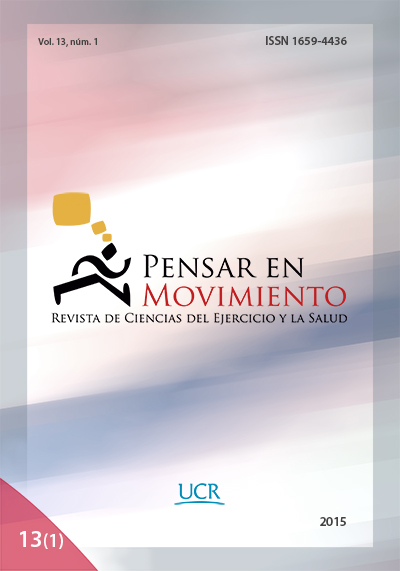Abstract
Due to the great impact that are exerting the networks in society, it is crucial to know the features that distinguish online social networks bringing together users interested in receiving information and resources to improve or maintain the body in shape. This article aims to comment on the limited research interested in studying the features and particularities of online communities that provide information, advice and support in the execution, performance and promotion of the health and fitness activities. Particularly, it underline about the necessity to know of networks structure, user profiles and peer-to-peer interaction, sort of membership, mechanisms of communication, representation of the body image and patterns of association. Likewise, the size of the support networks, telepresence, technology acceptance and perceived risk on the network. Besides, we recommend exploring two Fitness-related online social networks. Finally, it makes known the recurring problems in the analysis in order to characterize psychosocial and communicative aspects of users in the virtual environment.
References
Arroyo-Vázquez, N. (2009). El uso profesional de las redes sociales. Anuario ThinkEPI, 3, 145-152. Recuperado de http://www.thinkepi.net/el-uso-profesional-de-las-redes-sociales
Ávila de Tomás, J. F., Benito-Justel, F. & Beijinho do Rosario, R. F. (2013). El e-paciente. FMC - Formación Médica Continuada en Atención Primaria, 20(10), 602-607. Recuperado de http://dx.doi.org/10.1016/S1134-2072(13)70673-X.
Ba, S. & Wang, L. (2013). Digital health communities: The effect of their motivation mechanisms. Decision Support Systems, 55, 941–947. Recuperado de http://dx.doi.org/10.1016/j.dss.2013.01.003
Banias, P. & Malita, L. (2011). Can we use sport, web 2.0 and social & informal learning to develop & enhance social competences? Procedia Social and Behavioral Sciences, 15, 628–632. doi: http://dx.doi.org/10.1016/j.sbspro.2011.03.153
Centola, D. (December, 2011). An experimental study of homophily in the adoption of health behavior. Science, 334, 1269-1272. doi: http://dx.doi.org/10.1126/science.1207055
Centola, D., (2013). Social Media as a Tool in Medicine. Social media and the science of health behavior. Circulation, 127, 2135-2144. doi: http://dx.doi.org/10.1161/CIRCULATIONAHA.112.101816
Centola, D. & van de Rijt, A. (2015). Choosing your network: Social preferences in an online health community. Social Science & Medicine 125, 19-31. Recuperado de http://dx.doi.org/10.1016/j.socscimed.2014.05.019
De-Juanas, A., & Diestro, A. (mayo-agosto, 2012). Empleo de los medios sociales en educación superior: una nueva competencia docente en ciernes. REDU. Revista de Docencia Universitaria, 10(2), 365-379. Recuperado de http://red-u.net/redu/index.php/REDU/article/view/365
Del Moral, M. E. , & Martínez, L. V. (2012). Presencia de los futuros maestros en las redes sociales y perspectivas de uso educativo. Revista Latinoamericana de Tecnología Educativa-RELATEC, 11(1), 41-51. Recuperado de http://mascvuex.unex.es/revistas/index.php/relatec/article/view/843
Domínguez, D. C. (2010). Las Redes Sociales. Tipología, uso y consumo de las redes 2.0 en la sociedad digital actual. Documentación de las Ciencias de la Información, 33, 45-68. Recuperado de http://revistas.ucm.es/index.php/DCIN/article/view/DCIN1010110045A
Echeburúa, E., & de Corral, P. (2010). Adicción a las nuevas tecnologías ya las redes sociales en jóvenes: un nuevo reto. Adicciones, 22(2), 91-96. Recuperado de http://www.adicciones.es/files/91-96%20editorial%20echeburua.pdf
García-de-Torres, E., Yezers' ka, L., Rost, A., Calderín, M., Edo, C., Rojano, M., ...& Corredoira, L. (november-december, 2011). Uso de Twitter y Facebook por los medios Iberoamericanos. El profesional de la información, 20(6), 611-620. doi: http://dx.doi.org/10.3145/epi.2011.nov.02
Gallo, A., Orihuela, J. L., Paniagua, J., Villanueva, J., Villanueva, J., & Ziskind, J. (2011). Los medios sociales en España: la visión de la alta dirección. Recuperado de http://dogcomunicacion.com/wp-content/uploads/IESE-Social-Media.pdf
Giménez, D. (juny, 2010). Redes sociales: posibilidades de Facebook para las bibliotecas públicas. BiD: textos universitaris de biblioteconomia i documentació, (24). Recuperado de http://bid.ub.edu/24/garcia2.htm
Gómez-Aguilar, M., Roses, S. & Farias-Batlle, P. (2012). El uso académico de las redes sociales en universitarios. Comunicar, 38(19),131-138. doi: http://dx.doi.org/10.3916/C38-2012-03-04
Martínez,, R., Corzana, F. y Millán, J. (2013). Experimentando con las redes sociales en la enseñanza universitaria en ciencias. Revista Eureka sobre enseñanza y divulgación de las ciencias, 10(3), 394-405. Recuperado de http://reuredc.uca.es/index.php/tavira/article/viewFile/393/pdf_141
Menéndez, M. (2011). Las redes sociales y su efecto político. Telos, Cuadernos de Comunicación e Innovación, 89, 74-83. Recuperado de http://dialnet.unirioja.es/servlet/articulo?codigo=3809402
Puig, N., Vilanova, A., Camino, X., Maza, G., Pasarello, M., Juan, D., & Tarragó, R. (2006). Los espacios públicos urbanos y el deporte como generadores de redes sociales. El caso de la ciudad de Barcelona. Apunts. Educación Física y Deportes, 84, 76-87. Recuperado de http://www.revista-apunts.com/es/hemeroteca?article=130
Shalizi, C. R. & Thomas, A. C. (2011). Homophilyand contagion are generically confounded in observational social network studies. Sociololgical Methods & Research,. 40(2), 211-239. doi: http://dx.doi.org/10.1177/0049124111404820
Túñez, M., & García, J. S. (2012). Las redes sociales como entorno docente: análisis del uso de Facebook en la docencia universitaria. Píxel-Bit: Revista de medios y educación, (41), 77-92. Recuperado de http://acdc.sav.us.es/pixelbit/images/stories/p41/06.pdf






